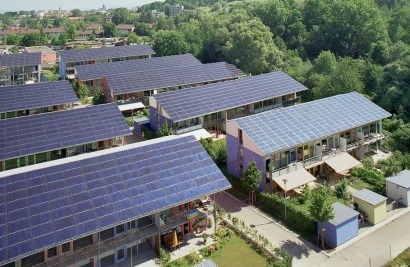
The study also explores the feedback effects between retail electricity rates and PV deployment, and suggests that increased solar deployment can lead to changes in PV compensation levels that either accelerate or dampen further deployment.
“We find that retail rate design can have a dramatic impact on PV deployment levels,” said report author Naïm Darghouth, a researcher in Berkeley Lab’s Energy Technologies Area. “For example, rate design changes currently being considered by a number of utilities, and modeled in our study, can dramatically erode aggregate customer adoption of PV (from -14 percent to -61 percent, depending on the design).”
The report, which uses a solar deployment model originally developed at the National Renewable Energy Laboratory, also examines PV deployment levels under broad adoption of time of use rates, purely volumetric rates, feed-in tariffs, and avoided cost based rates. Most of these scenarios lead to deployment levels lower than under a continuation of net metering and current rate designs.
The report also considers two potential feedback effects between solar deployment and retail electricity rates. The first, commonly-noted feedback occurs if increased solar deployment leads to under-recovery of utility fixed costs, creating a need to increase retail electricity prices, thereby accelerating solar deployment. A second, less-frequently discussed—and opposing—feedback occurs when increased solar deployment causes a shift in the timing of peak electricity pricing, which tends to dampen solar adoption by customers on time-of-use rates.
“Our study shows that—at least on a national basis—these two feedback effects largely counteract one another. As such, current discussions that focus largely on the fixed-cost recovery feedback miss an important and opposing feedback mechanism that can in many circumstances moderate the issue of concern,” said Berkeley Lab’s Ryan Wiser, a co-author on the report.
Exemplifying these feedbacks are the deployment impacts from switching all customers to time-varying rates. In the shorter term, up to about 2030, the study finds that PV deployment is greater than in the reference scenario – a result of the higher average compensation for PV under time-varying rates which boosts PV deployment.
However, as regional PV levels increase and the energy and capacity value of PV drops, the compensation for net-metered PV generation under time-varying rates also falls, which leads to lower PV deployment levels. Therefore, proposals to move towards time-varying rates may boost PV deployment in the shorter term, but may actually reduce PV deployment in the longer term.
The report was motivated by the fact that rapid growth of net-metered solar PV has provoked concerns about the financial impacts of that growth on utilities and ratepayers. To address these concerns, an increasing number of states are exploring changes to net metering rules, retail rate structures, or both.
According to report co-author Galen Barbose, “Understanding the deployment impacts of potential reforms to rate design and net metering will be critical for regulators and other decision makers as they consider changes to retail rates, given the continued role of PV in advancing energy and environmental policy objectives and customer choice. This report makes a unique contribution by quantitatively assessing these possible deployment impacts.”
This research was supported by funding from the U.S. Department of Energy’s SunShot Initiative.
For additional information:

